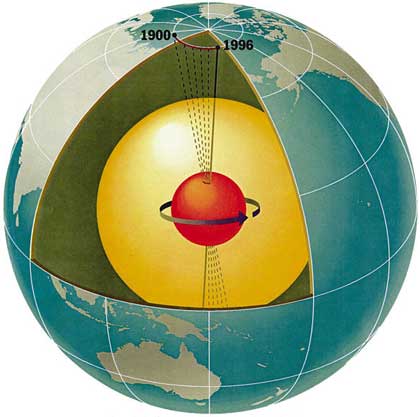The nucleus of the Earth - Earth core
The core is the nucleus of the Earth. From the bottom of the Mantle lower layer extends into the center, about 3,473km. According to analysis of monitoring data, it is divided into 3 layers: outer core layer, transition layer and inner core layer.
How is the Earth core structured?
The thickness of the outer core layer is 1,742km, the average density is about 0.5g / cm3, liquid.
The thickness of the transitional layer is only 515km, the material transcends from liquid to solid.

The thickness of the inner core is 1,216km, the average density is 12.9g / cm3, the main component is iron and nickel, so it is also called the nickel iron core.
The total weight of the earth core is 1.88x1021 tons, accounting for 31.5% of the total weight of the Earth.
Volume is 16.2% Earth volume. The volume of the earth core is even bigger than Mars. Because the soil core is the deepest, the pressure is greater than that of soil and mantle.
The external core pressure is 1.36 million atm to the core in pressure up to 3.6 million atm. Such great pressure is hard to imagine for us on the ground. A scientist has experimented, in the case of 1cm3 bearing force of 1,770 tons, diamond - the most solid, also softened.
In addition, the temperature in the soil core is also very high, estimated at 2,000-6,000 degrees Celsius. The average density is 10-16g / cm3. Under such conditions of pressure and temperature, the concept of ordinary solid or liquid form no longer means anything. The iron in it is just as hard as iron, but soft as bitumen (plastic). The substance is more than ten times stronger than iron, but it can deform slowly without cracking.
The special nature of the soil core cannot be imitated even in modern laboratories, so little is known. But there is one point that scientists do not suspect is that the soil core is never quiet , the substances in the earth are moving constantly. Some scientists believe that matter inside the Earth not only conveys movement between the upper and lower layers. But the speed is very slow, only about 1cm each year. There are scientists also deduced that the matter in the earth is subject to the gravitational force of the Moon, the Sun vibrates in a rhythmic way.

(Photo: physics.uoregon)
The central point of the Earth lies at a depth of more than 6,000 km. Even the outer edge of the Earth's core is as deep as 3,000 km below our feet.
The deepest hole that humans have ever drilled on the surface of the Earth is Kola Superdeep Borehole in Russia and it is down only modestly, 12.3 km.
All familiar phenomena on Earth occur near the surface.
Lava erupting from volcanoes first melted at a depth of several hundred kilometers. Even diamonds, which are only created under extreme heat and pressure conditions, are located only in deep rock layers less than 500km.
- Decipher the mystery of the Earth's inner core
- Discover one more layer of the earth's core
- Find out the last ingredient that makes up the Earth core
- Earth's core temperature is unexpectedly high
- Detecting Earth core layers rotate in different directions
- The core of the Earth leaked more than 2.5 billion years ago, what is happening?
- For the first time, we have evidence that Earth's inner core exists in solid form
- May 13: Celebrating 128 years of birth, the person who finds Earth's core
- New hypothesis about the behavior of the Earth's core
- Discovering the 720,000-year-old ice core could be a
- New discovery of the heat of Earth's core coating
- Core Earth originated from supernova?
 Van Allen's belt and evidence that the Apollo 11 mission to the Moon was myth
Van Allen's belt and evidence that the Apollo 11 mission to the Moon was myth The levels of civilization in the universe (Kardashev scale)
The levels of civilization in the universe (Kardashev scale) Today Mars, the sun and the Earth are aligned
Today Mars, the sun and the Earth are aligned The Amazon owner announced a secret plan to build a space base for thousands of people
The Amazon owner announced a secret plan to build a space base for thousands of people